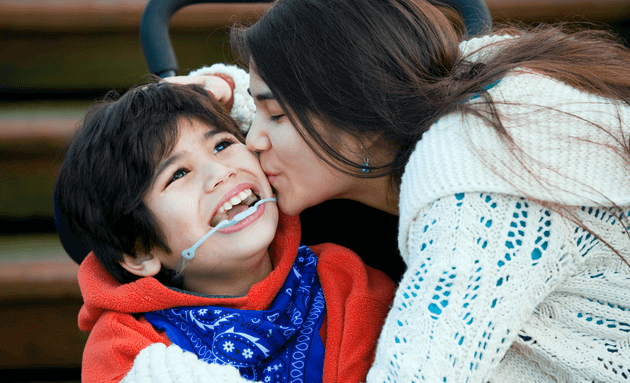Cerebral Palsy is a neurological condition that affects movement. It is the most common motor disability in children and can affect 1 in 500 newborns around the world. This World Cerebral Palsy Day, here are 9 things you need to know about this common movement disorder.
There Are Several Types of Cerebral Palsy
Cerebral Palsy is a term used to describe a set of neurological conditions that hinder motor ability. It can manifest in three primary ways :- Spastic Cerebral Palsy
- Flaccid Cerebral Palsy
- Athetoid Cerebral Palsy
- Ataxic Cerebral Palsy
- Mixed Cerebral Palsy
What Causes Cerebral Palsy?
Cerebral Palsy occurs when there is damage to the cerebrum or upper part of the brain. The cerebrum is responsible for memory, ability to learn, and communication skills. The three causes that can lead to Cerebral Palsy at the time of birth are:
Periventricular leukomalacia (PVL): damage to the brain due to lack of oxygen
Abnormal development of the brain during the first 6 months of pregnancy
Intracranial haemorrhage or stroke in the fetus.
Periventricular leukomalacia (PVL): damage to the brain due to lack of oxygen
Abnormal development of the brain during the first 6 months of pregnancy
Intracranial haemorrhage or stroke in the fetus.
Specific causes of Cerebral Palsy in most children is unknown. But some cases are caused due to brain damage more than 28 days after birth. This is called acquired Cerebral Palsy.
Cerebral Palsy Is NOT an Intellectual Disability
Children with Cerebral Palsy may show signs of intellectual disability due to poor brain functioning. It is, however, not an exclusive intellectual disability. Most people living with Cerebral Palsy have average or above-average intelligence and can function like any other person.What Can Increase the Chances of Cerebral Palsy in a Newborn?
Most cases of Cerebral Palsy is caused because of brain damage that happened before or during birth. The following factors can increase the risk for Cerebral Palsy:- Being born too small or underweight
- Being born prematurely
- Being born a twin or other multiple births
- Being conceived by in vitro fertilisation or other assisted reproductive technology
- Having a mother who had an infection during pregnancy
- Having kernicterus (a type of brain damage that can happen when severe newborn jaundice goes untreated)
- Having complications during birth
Symptoms of Cerebral Palsy may differ in different people based on the location of the brain injury. However, common symptoms include:
- Seizures and epilepsy
- Below average intelligence
- Difficulty controlling bladder and bowel movements
- Attention deficit hyperactivity disorder (ADHD)
- Slow and convoluted movements of limbs, or athetosis
- Behavioural problems like dependency or antisocial behaviours
- Visual/hearing impairments
- Speech and language issues (dysarthria)
- Sensory impairments/pain
Cerebral Palsy May Often Be Difficult to Diagnose
Cerebral Palsy exhibits symptoms like seizures and lack of coordinated movement. However, a majority of such cases are usually dismissed as a brain injury, until seizures show up more often and then diagnosed as Cerebral Palsy.Similarly, uncontrollable spasmodic movements may also have been caused due to movement disorders, or something like acid reflux, ear infection or side effect of a medication. Thereby, it becomes difficult to diagnose Cerebral Palsy correctly, especially in non-verbal children.
Most children are diagnosed by the age of 3. However, you can watch out for these early signs of Cerebral Palsy in your child:
In a baby 3 to 6 months of age:
Head falls back when picked upThe body feels stiff or floppy
Seems to overextend back and neck when cradled in someone’s arms
Legs get stiff and cross or scissor when picked up
In a baby older than 6 months of age:
Doesn’t roll over in either directionCannot bring hands together
Has difficulty bringing hands to mouth
Reaches out with only one hand while keeping the other fisted
In a baby older than 10 months of age:
Crawls in a lopsided manner, pushing off with one hand and leg while dragging the opposite hand and legMoves around on buttocks or hops on knees, but does not crawl on all fours
People With Cerebral Palsy Can Be Independent
Although there is no cure for Cerebral Palsy, early intervention can help manage symptoms and enable an independent life for someone with Cerebral Palsy. Treatment depends on individual needs and gets revised as and when the child grows older. The aim is to equip the child with as many skills for an independent life. Being patient and proactive is the best way to manage someone with Cerebral Palsy.
People With Cerebral Palsy Experience Physical Pain
25% of children with Cerebral Palsy experience physical pain due to abnormal use of muscles and joints, while 84% of adults experience physical pain. This happens over a period of time due to wear and tear of the muscles.Cerebral Palsy Is a Highly Misunderstood, Stigmatised Medical Condition

Largely due to the media’s description of the condition, there are pervasive misconceptions about Cerebral Palsy. It is often referred to as a “disease”, mistaken as genetic or progressive, and stigmatise people living with it.
Cerebral Palsy is like any other medical condition. This World Cerebral Palsy Day, let’s educate ourselves about it and help reduce the stigma around it.


0 Comments